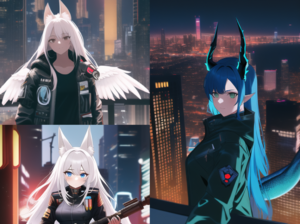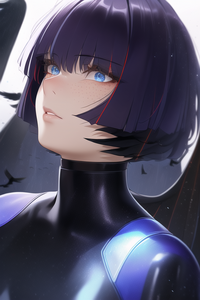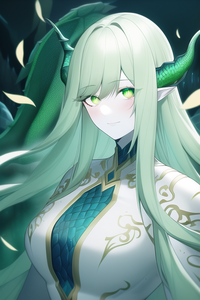Kemonomimi (Sparkalia)
This article is incomplete because it is pending further input from participants, or it is a work-in-progress by one author. Please comment on this article's talk page to share your input, comments and questions. Note: To contribute to this article, you may need to seek help from the author(s) of this page. |
Kemonomimi (Nihongo: 獣耳) also known as Jaanavarkaans (Nepali: जनावरकान) are humans with animal-like traits, Human-Animal Hybrid's come in varying shapes, sizes, along with different animal-traits. Oftentimes distinguishable by their ears, tails, or wings if they have said features. Their phenotypes are not limited to real life animals and can encompass even mythical creatures such as griffins and dragons.
Genetic Traits
Ears
Depending on the type of Kemonomimi, some Kemonomimi's have enhanced hearings that are better than the human ear. Being able to hear different wavelengths, though while that comes with it's advantages, it also has some disadvantages. Such as sensitivity to loud noises. This can be dependent from the type of ears and how many hair cells there are in the ear.
Tails
Also varies from type of Kemonomimi, tails can act as both an extra limb and a balance, a pain to brush and maintain them (unless they are scaly) and they can get in the way of things when sitting or wearing clothes though. So they would need specialized clothes to be able to feel comfortable in clothing. Warning is to not touch a Kemonomimi's tail! Their tails are packed with nerves and are very sensitive and so touching them can agitate or aggravate them. You have been warned!
Wings
Some Kemonomimi's have wings that grants them the ability to fly, albiet that unless they train their wings to carry super heavy stuff they do not have limitless flight abilities and can feel tired after flying for too long. Wings are also a big hassle to maintain and also get in the way of clothing so they also need special clothing to feel comfortable.
Nations with native Kemonomimi
Santi Rasta
Santinese Kemonomimi's are known as either Jaanavarkaans , Paksheekaans, or Pashukaans. They differ from Kemonomimi's as they were genetically modified by a Galactic Empire as products to be 'manufactured' and sold to other galactic nations who require Kemonomimi's for labor or servitude. Santinese Kemonomimi were apart of a shipment of fresh and old servants and labors that were being transported to another galactic empire until a miscalculation or a problem with the AI navigation system led most of the shipment or all of it to crash onto Sparkalia. Introducing the planet to the Santinese Kemonomimi sentient lifeforms.
Paksheekaans are people with avian traits, they differ with avian-like wings that give them the ability to fly for a certain amount of time and a certain height depending on how much the wings can withstand and how light they are. Though their wings also differ depending on how large their wingspan is or if it is able to support their body weight.
Pashukaans are humans with reptile traits, they are not cold blooded fortunately due to being human-like. Pashukaans with dragon-like traits also fit into this category due to having scales & have the ability to fly or not but are limited alike the Paksheekaans in terms of the height of flight, lightness, and duration.
All Kemonomimi's of Santi Rasta have the BEUX/N318 Gene, mostly making them exceptionally beautiful. As the galactic customers who have purchased this set of population may have wanted their 2nd class citizens to not look horrid and be able to fit in with society and work as retails or other dead-end jobs.
Some Santinese have large fur, feather, or scale growths on their arms and legs due to a modification in the FSUG/N182 Gene. Which makes their hair trap heat & stay warm (or to create a second layer of insulation) as well as accelerate fur/scale/feather growth. This is to perhaps have them work in areas where it is cold and avoid getting frostbites around the limbs where so that they can continue to work rather than put them out of comission.
It is also to be noted that some have been made infertile due to chemical and radiation leaks during the trip to Sparkalia, though many Santinese have FLTR/N734 modified to allow them to be more fertile and guarantee new younger workers for the clients who purchased this batch of population.
Santinese people also have cybernetics, installed by their creators, mainly many if not all have Chipware Socket where chips are inserted. A neural processor located at the base of the spine, which translates the chip data into useful information, and a set of interface plugs or chipware sockets are located at the Trapezius. Neuralware have also been inserted into their Central & Peripheral Nervous System along with parts of the brain which modify the release of hormones such as oxytocine, dopamine, etc.
Due to this, groups of people that follow either no religion or are Galacalican followers are oftentimes transhumanist, while many Gaianian followers are opposed to transhumanism and wish to keep their flesh pure. Thus there is an investment into cybernetics, implants and other cyberware in Santi Rasta.
Jaanavarkaans are animal-eared people, they look human but are distinguishable by their animal-like tails and animal-like ears. They differ from the Paksheekaans and the Pashukaans as their phenotypes are based on land animals and those that are not avians or reptiles.
Jaavarkaans make up about 65.4% of the population of Santi Rasta. Mainly speak Premani (Lit. Language of Love/Affection), which is the main and national language of the nation. The Jaavarkaans are very different from one to another phenotypically but not so much genotypically.
It is hypothesized that Jaanvarkaan's have been made for clients that wanted servants that looked human-like and are beautiful/cute, as well as produce a lot of offsprings. Or made by a nation that wanted to expand their population after a worker shortage or a crisis and thus resorted to buying genetically grown and modified people in order to makeup for the shortage in the workforce or population.
Some Jaanvarkaan's have also specialized cyberware produced by their overlord, mainly Cyberaudio which enhances hearing and Cyberlimbs which replace their limbs with more stronger and durable limbs.
Paksheekaans
Paksheekaans are people with avian traits, they differ with avian-like wings that give them the ability to fly for a certain amount of time and a certain height depending on how much the wings can withstand and how light they are. Though their wings also differ depending on how large their wingspan is or if it is able to support their body weight.
Paksheekaans make up about 16% of the population of Santi Rasta. Mainly speak Namchu (Lit. Language of the Winds). The Paksheekaans are very different from one to another phenotypically though not genotypically.
Paksheekaans are hypothetized to be made mainly for military purposes. Either serving as small aerial units that drop bombs or fire rounds upon enemies from high above. Though it is not much certain as this can also be accomplished by unmanned aerial vehicles (UAV's) and aerial drones, so it is unknown what the exact purpose could be.
All Paksheekaans have implants within their wings to perhaps help with enhancing bone density along with muscle density around the wings as well as a genetically modified thyroid glands that produces calcitonin at moderately high levels so as to increase calcium salt levels in the bone and modify parathyroid glands to produce parathyroid hormones at moderate lower levels so as bone density doesn't decrease. Hence why Paksheekaans need to have a bit more Calcium within their systems. Though when a Paksheekaan mothers is pregnant, their parathyroid and thyroid hormones respond by producing low levels of calcitonin and high levels of parathyroid hormones which get deposited into their breast milk in order to feed their offsprings with the right amount of calcium so as they don't have bone deficiencies later on. It is recommended that Paksheekaan mothers also consume a lot of calcium in their diet as during pregnancy the bones will be weaker than normal circumstances.
Pashukaans
Pashukaans are humans with reptile traits, they are not cold blooded fortunately due to being human-like. Pashukaans with dragon-like traits also fit into this category due to having horns and either have the ability to fly or not but are limited alike the Paksheekaans in terms of the height of flight, lightness, and duration.
Pashukaans make up about 18.6% of the population of Santi Rasta. Mainly speak Terkatal (Lit. Language of the Land). The Pashukaans are very different from one to another phenotypically though can also be genotypically be different if they are drakes or not.
Pashukaans with dragon-like traits and wings have the same implants and genetic modifications as all Paksheekaans have, thus are also recommended to consume a lot of calcium in their diet during pregnancy so as to avoid weaker bones.
Pashukaans may have been made as foot soldiers due to their scales along with reptilian tails. Which are made of hardened scales that seem to have a lot of muscle mass to knock down a person using blunt force. Scales are also bullet proof to 9mm rounds. Though they also have neuralware that overrides the pain receptors that allow the CNS & PNS to communicate pain in different areas. While the idea of feeling little pain is a bless. At times, there are gunfights involving Pashukaans that take on a heavy amount of bullets and flick them off like it is nothing, at the end of the fight they either faint and die due to organ failure because they didn't retreat or seeked medical attention to their wounds even though they were in critical condition. Due to this Pashukaans have a bit of a higher deathrate in firefights.
Shinkei
In the Organization of Shinkei and its controlled territories, Kemonomimi is grouped into the Juuzoku (兽族, Beast Race). They are classified into two categories by the Organization and registered by the Interrace Cooperation Association in Leiden as followed:
- Humanoid Beast have a resemblance to humans, with the exception of possessing animalistic ears and a non-prehensile tail, though some may lack either feature. They also possess race-specific traits such as horns or feathers. They are registered as Ningen-jū (人間獣, Human Beast).
- Anthropomorphic Beast can be described as sentient bipedal beings with the physical features of the respective animal or creature they are based on. They are registered as Yajū (野獣, Feral Beast).
The Beast Race appeared on Jūmin-ryōiki Island shortly after the Great Restart occurred, launching them into an area where adaptability was harsh. With nowhere to go, the Beast Race were gathered by the humans and other races and they settled in the place now known as the Great Forest in Libe. Their primary language is Beast Tongue.
The Beast Race in Shinkei is similar to humans in appearance, with the difference of having traits of other mammals on their bodies. Their lifespan is also similar to humans, while their physical capabilities are slightly superior. They are capable of using a unique magic called Howling, which allows them to infuse their voice with magic to perform echolocation or incapacitate their enemies. They also possess an enhanced sense of smell that could identify the faint scent of different people or even the smell of arousal. However, their enhanced sense of smell is also their weakness, making them prone to being disabled by strong scents or smoke.
In terms of physical appearance, the Beast Race has a wide range of animal traits, such as fur, claws, tails, and horns. Some Beast Race members also possess the ability to transform into their animal form, although this ability is not common among them. In addition to their enhanced sense of smell and unique magic, the Beast Race also has strong physical capabilities, particularly in terms of agility and reflexes. The Beast Race's mating season is a significant event in their society, with members eagerly anticipating it and preparing for the duels that take place during this time. The duels can range from friendly sparring matches to intense fights to establish dominance. Once the winner is determined, the dominant member becomes the leader in the relationship, with the other member accepting a submissive role. This dynamic is accepted and valued in Beast Race culture, as it helps to establish strong, committed relationships and ensures the continuation of their species.
The Beast Race has a rich history and culture, shaped by their origin and their subsequent migration to Jūmin-ryōiki Island. Their beliefs and traditions are deeply rooted in their connection to nature, and they revere the spirits of animals as well as the Beast God who created them. The Beast Race also has a close relationship with other races on the Island, having been gathered and protected by them after the Great Restart. Despite their similarities with humans, the Beast Race have faced discrimination and prejudice from some human communities, especially due to their animal traits.




